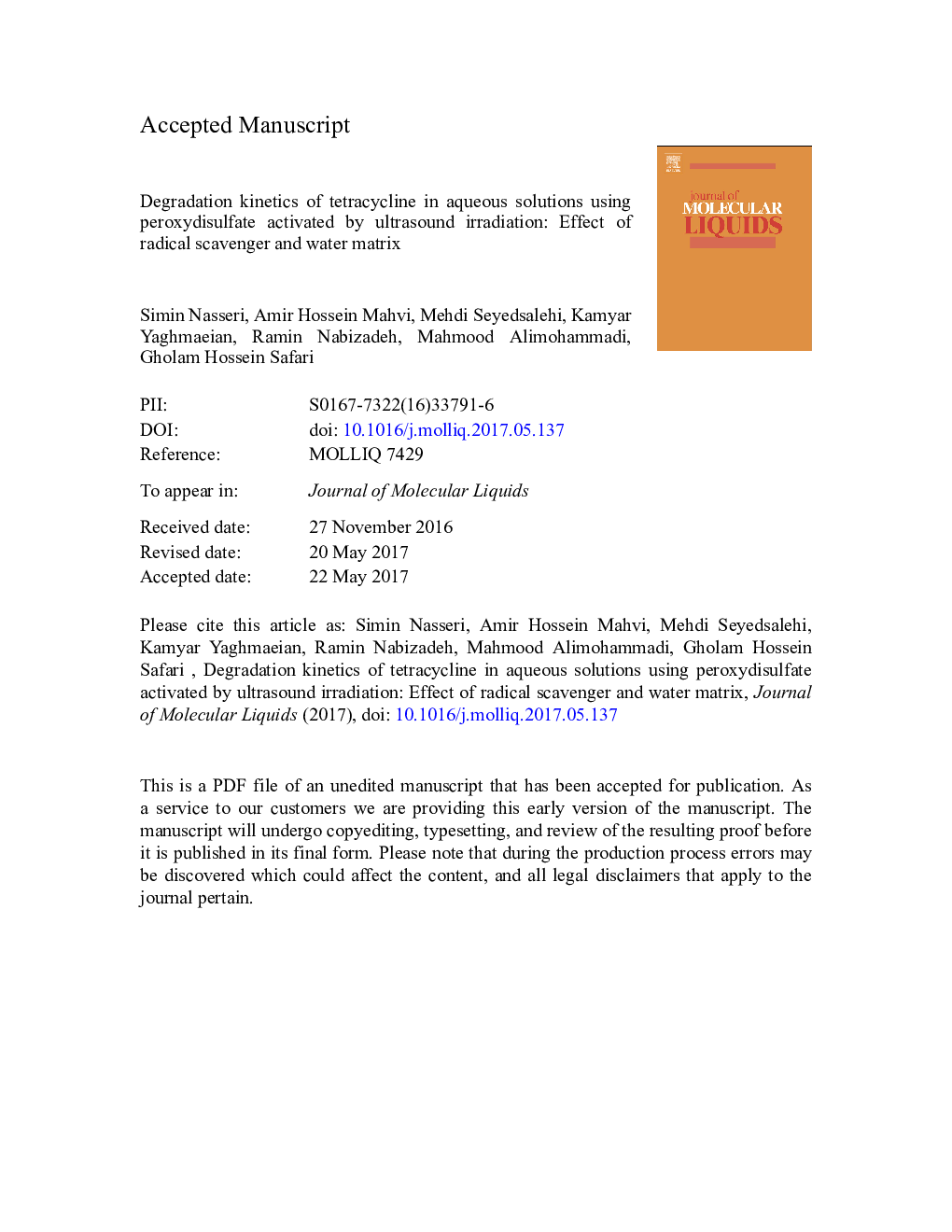| کد مقاله | کد نشریه | سال انتشار | مقاله انگلیسی | نسخه تمام متن |
|---|---|---|---|---|
| 5408377 | 1506530 | 2017 | 42 صفحه PDF | دانلود رایگان |
عنوان انگلیسی مقاله ISI
Degradation kinetics of tetracycline in aqueous solutions using peroxydisulfate activated by ultrasound irradiation: Effect of radical scavenger and water matrix
ترجمه فارسی عنوان
سینتیک تضعیف کننده تتراسایکلین در محلول های آبی با استفاده از پراکسی دی سولفات فعال شده توسط اشعه ماوراء بنفش: اثر تجمع رادیکال و ماتریس آب
دانلود مقاله + سفارش ترجمه
دانلود مقاله ISI انگلیسی
رایگان برای ایرانیان
کلمات کلیدی
TBAMTBEPMSTCSTOCTCALC-MSPDSAOPs - AOP هاSTP - PTSUV–Vis - UV-VisBottled water - آب بطریultrapure water - آب فوق العادهdeionized water - آب یونیزه شدهHumic acid - اسید هیومیکUltraviolet - اشعه فرابنفشultraviolet visible - اشعه ماوراء بنفش قابل مشاهده استTert-butyl alcohol - تتر بوتیل الکلTetracycline - تتراسایکلینTetracyclines - تتراسیکلین هاSonochemical degradation - تخریب سلولیTrichloroethane - تریکلوراتانchemical oxygen demand - تقاضای اکسیژن شیمیاییSulfate radical - رادیکال سولفاتKinetics - سینتیک (جنبش شناسی) Tap water - شیر آبSecondary effluent - فاضلاب ثانویهUltrasound - فراصوتAdvanced oxidation processes - فرایندهای اکسیداسیون پیشرفتهMethanol - متانولmethyl tert-Butyl ether - متیل ترتل-بوتیل اترNatural organic matter - مواد آلی طبیعیNOM - نامPeroxymonosulfate - پراکسی مونوسولفاتPeroxydisulfate - پراکسید سولفاتPersulfate - پرسولفاتCod - کادوhigh-performance liquid chromatography - کروماتوگرافی مایعی کاراHPLC - کروماتوگرافی مایعی کاراTotal organic carbon - کل کربن آلیSewage treatment plants - گیاهان فاضلاب
موضوعات مرتبط
مهندسی و علوم پایه
شیمی
شیمی تئوریک و عملی
چکیده انگلیسی
Degradation kinetics of the tetracycline antibiotic in aqueous solution was investigated using sulfate radicals under ultrasound irradiation. The effect of various operational parameters including initial tetracycline concentration, initial peroxydisulfate concentration, solution pH, reaction time, temperature, ultrasound power, the presence of natural organic matter, radical scavenger (tert-butyl alcohol and methanol), as well as the chemical composition of water using ultrapure water, drinking water, and secondary effluent on the degradation efficiency of tetracycline were studied. The preliminary studies were performed using only peroxydisulfate, ultrasound and ultrasound activated peroxydisulfate. The results indicated that tetracycline degradation rate increased with the increase of initial peroxydisulfate concentration, temperature and ultrasonic power, but decreased with the increase of initial tetracycline concentration. The tetracycline degradation rate was highly dependent of initial pH of the solution. The degradation of tetracycline followed the first-order kinetics. The addition of humic acid in concentrations above 10 mg·Lâ 1 decreased the degradation rate of tetracycline, although the effect could be compensated using higher concentrations of peroxydisulfate. The role of active radicals (sulfate and hydroxyl radicals) was investigated using radical scavengers of methanol and tert-butyl alcohol. Under optimum operational conditions, 96.5% of tetracycline removal was achieved with chemical oxygen demand and total organic carbon removal of about 74% and 61.2%, respectively. The degradation rate of tetracycline was higher in drinking water compared to ultrapure water. Finally, the intermediates were identified and the possible degradation pathway of tetracycline was investigated. Overall, ultrasound activated peroxydisulfate was found to be a promising process for tetracycline degradation in aqueous solutions.
ناشر
Database: Elsevier - ScienceDirect (ساینس دایرکت)
Journal: Journal of Molecular Liquids - Volume 241, September 2017, Pages 704-714
Journal: Journal of Molecular Liquids - Volume 241, September 2017, Pages 704-714
نویسندگان
Simin Nasseri, Amir Hossein Mahvi, Mahdi Seyedsalehi, Kamyar Yaghmaeian, Ramin Nabizadeh, Mahmood Alimohammadi, Gholam Hossein Safari,
